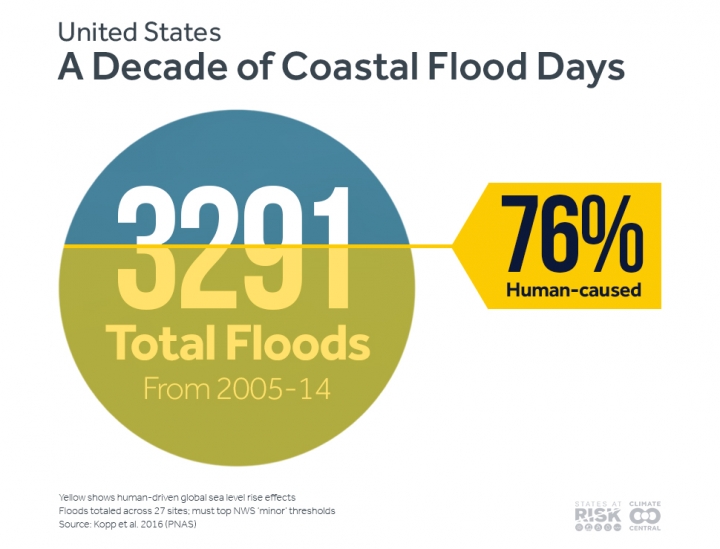| 正文(英文): |
Research Report by Climate Central
Parts of the Atlantic Coast are still recovering from the onslaught of Hurricane Matthew, but even more flooding is on the way as local tides will reach some of their highest points of the year. With little chance to recover between events, coastal cities are facing a constant reminder that climate change has already tipped the scales toward more frequent and bigger floods.
When the earth, moon, and sun are in perfect alignment, gravity pulls the oceans to their highest tides, often afflicting coastal communities with minor or nuisance flooding that can close roads, inundate local businesses, erode beaches and cause sewage overflows. And as global warming accelerates sea level rise, these floods — often called sunny day floods — are increasing; in many locations they’re occurring 10 or 20 times a year.
This week, points along the Atlantic and Gulf Coasts will be experiencing those highest of high tides — commonly known as king tides. But added to this natural tidal cycle are several inches of water brought on from an unnatural source: us. Rising temperatures over the past century — mostly fueled by our carbon emissions from fossil fuels — have caused sea levels to rise, which has made high tides even higher than they used to be in most places. And with sea level rise accelerating, this week’s king tides, and the floods they will deliver, give us a preview of what everyday water levels will soon be like because of global warming.
While flooding from king tides, and similar floods from storms or high winds, aren’t usually as severe as the ones doled out by hurricanes and tropical storms, they happen much more frequently. Recent research attributes about 6 inches of the world’s sea level rise that has occurred since 1900 to human-caused global warming. And given current levels of carbon emissions, that rate is expected to accelerate. Scientists project that sea level rise could surpass 3 feet by the end of the century. At the local level, sea level rise amounts to higher water lines during high tides, so local thresholds for minor floods are surpassed more frequently now than in the past.
The States at Risk program has investigated how many of these sunny day floods can be attributed to human-caused climate change — in other words, how many more flood days we have created because of the higher water levels from sea level rise. At 27 locations across the East, West, and Gulf Coasts, we found that 76 percent of the cumulative flood days from 2005-2014 (2,505 of the 3,291 flood days) would not have happened in the absence of climate change.

In some locations, the influence from our carbon pollution is particularly dramatic: in 11 places, ranging from the Miami area, to Wilmington, N.C., to Seattle, more than 80 percent of flood days in a 10-year span can be attributed to human-caused sea level rise. And in both Honolulu and Fernandina Beach, Fla., all of the flood days (138 days and 16 days, respectively) between 2005-2014 were made possible by climate change.
Only two of the 27 locations, Galveston, Texas, and St. Petersburg, Fla., saw fewer than half of their flood days because of sea level rise caused by us.
A decade of coastal flood days
Updated local flood counts for 2015 and 2016, plus current water levels and local flood threshold elevations, are available for most areas nationwide at riskfinder.org.
The States at Risk findings are based on a broader February 2016 Climate Central analysis that looked at the human-caused sea level rise contribution to nuisance flooding over a 65-year period. That study focused on 27 tidal gauges with high quality hourly water level records dating back several decades. Since 1950, 67 percent of all flood days would not have happened without the sea level rise that has taken place because of rising greenhouse gas emissions that are warming the planet. But this human contribution has accelerated in recent years as sea level rise rates have increased, so a disproportionate number of nuisance floods that are happening now simply wouldn’t have happened even a few decades ago.
Climate Central’s analysis built upon research from Rutgers University that quantified how much the global warming caused by rising greenhouse gas emissions have added to sea level since the beginning of the 20th century.
Analysis by Benjamin Strauss. Special thanks to Robert Kopp (Rutgers University), William Sweet (NOAA), and Klaus Bitterman (Potsdam Institute for Climate Impact Research) for work on the original analysis.
|